
Grassfed and pastured-based sheep and goats are indeed versatile and sustainable livestock, and they are well-suited for regenerative farming and climate adaptation. They bring several benefits relevant to regenerative agriculture, prairie or pasture health, biodiversity, and climate resilience:
- Adaptation to Diverse Climates: Sheep, especially goats, possess physiological and behavioral adaptations that help them withstand heat and drought. For example, goats have enlarged ears, thin skin, and efficient heat dissipation mechanisms, making them more thermotolerant and resilient in hot, arid, or semi-arid climates. They can reduce metabolic activity during feed scarcity to conserve energy. Sheep and goats generally face less heat stress than larger ruminants, making them good choices for farms in changing or extreme climates. Rotational grazing sheep and/or goats in a holistic way with other species makes for a good balance.
- Efficient Feed Use and Grazing: Goats have a browsing feeding habit, enabling them to consume a wider variety of vegetation, including shrubs and invasive plants that cattle avoid. This helps limit the overgrowth of invasive species and supports plant diversity, improving pasture biodiversity and ecosystem health. Their efficient use of poor-quality forage reduces pressure on grasslands.

- Soil Fertility and Grazing Impact: Grazing by small ruminants like sheep and goats contributes to nutrient cycling. Their manure naturally fertilizes soils with essential nutrients, while their movement also improves soil aeration to some degree. Managed grazing by sheep and goats can help maintain healthy pastures and prevent woody plant encroachment.
- Multiple Product Uses: Sheep and goats provide diverse outputs, including meat, milk, and fiber, adding economic value and dietary diversity to sustainable farms. Goat meat and milk are often lean and nutritious, with lower saturated fat and good vitamin content, aligning with health-conscious consumer demand.

- Climate Change Resilience: Their adaptability, efficient feed conversion, and tolerance to water scarcity enhance farm resilience to climate stresses. Goats tend to produce less enteric methane than cattle or sheep and show better water conservation capability.
- Role in Regenerative Systems: Small ruminants can be integrated into multi-species grazing systems with cattle or bison, optimizing pasture use, reducing parasite loads, and improving overall land regeneration outcomes.

Sheep and goats are well-adapted to a variety of climates and landscapes, making them ideal for sustainable, regenerative farms. Their grazing habits improve soil fertility and prevent overgrowth of invasive plants. Grassfed products from these animals provide diverse foods, including meat, milk, and fiber, while supporting biodiversity and climate-resilient agriculture.

